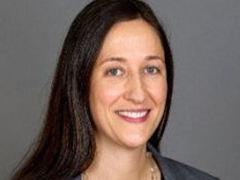Teaching Guide on Innovating in Healthcare
Video Vignette: Innovating in Healthcare
Featuring: KateSurman
Background on Kate Surman:
Kate Surman earned her MBA at Stanford Graduate School of Business and then launched her career in hospital management with her first role as Director of Process Excellence in the Stanford Hospital and Clinics. She then served as the Administrative Director of the Patient Care Services before becoming the Administrative Director of Strategic Operations. Given her experience, she was selected to be the Administrative Director at the South Bay Cancer Center where she led an innovative approach to the building design to support the new processes spearheaded in healthcare by the Hospital.
Summary: Given the opportunity to shape a new patient experience with the construction of a new hospital, a leader works to better understand the patient experience and design a new method of care.
Takeaway: User centric design takes shape in the many forms and results in quick learning, insightful feedback and process improvement.
Considerations and Questions:
1- What about the prototyping process was helpful in Kate’s overall effort to innovate?
2- What do you think about Kate’s idea to use a committee to help provide insights into the user experience for overall improvement?
3- What are the tradeoffs of selecting an innovative solution that prioritizes the patient over the hospital staff and option of design would benefit the patient the most?
4- What is especially challenging about innovating in a highly regulated industry? What are the opportunities?
Video Vignette: Innovating in Healthcare
Featuring: Kate Surman
Segment 1:
Summary: Given the opportunity to shape a new patient experience with the construction of a new hospital, a leader works to better understand the patient experience and design a new method of care.
Considerations and Questions:
1- Do you think engaging a committee to explore patient needs is worth the investment of time and management challenges? Why or why not?
2- Do you think prototyping potential solutions is important? Why or Why not?
3- What option would you determine to be most compelling for Kate?
4- In your own organization how do you set up prototypes to test concepts or products?
Video Vignette: Innovating in Healthcare
Featuring: Kate Surman
Segment 2:
Summary: Kate Surman must commit to a solution and do everything she can to understand the pros and cons to anticipate issues.
Considerations and Questions:
- What kind of a strategy would be most effective in getting experts to change how they provide care?
- What must be part of the prototyping process?
- How could Kate have better anticipated issues?
- In your own experience, what do you do to anticipate issues with implementing new ideas and products?
Video Vignette: Innovating in Healthcare
Featuring: Kate Surman
Segment 3: Results and Lesssons Learned
Summary: Kate Surman commits to a path and has mixed results that require quick responses, which are ultimately well received.
Considerations and Questions:
- How did Kate’s expectations match her strategy and results? What could she have done better? What did she do well?
- What surprises you about the results Kate experienced from this effort to innovate and drive adoption?
- What steps do you always take when driving innovation in your work?
Summary: Kate Surman shares lessons she learned from driving large innovations in patient care at all levels of the hospital experience.
Considerations and Questions:
- Do you agree with the lessons Kate shares from her experience?
- How do you balance personal sacrifices with driving innovation?
- What steps can you take to lead innovative efforts that do not cause potential burn out?
- What lessons can you share about success you have had in leading innovation?
Video Vignette: Innovating in Healthcare
Featuring: Kate Surman
Segment 1:
Summary: Given the opportunity to shape a new patient experience with the construction of a new hospital, a leader works to better understand the patient experience and design a new method of care.
Considerations and Questions:
1- Do you think engaging a committee to explore patient needs is worth the investment of time and management challenges? Why or why not?
2- Do you think prototyping potential solutions is important? Why or Why not?
3- What option would you determine to be most compelling for Kate?
4- In your own organization how do you set up prototypes to test concepts or products?
Video Vignette: Innovating in Healthcare
Featuring: Kate Surman
Segment 2:
Summary: Kate Surman must commit to a solution and do everything she can to understand the pros and cons to anticipate issues.
Considerations and Questions:
- What kind of a strategy would be most effective in getting experts to change how they provide care?
- What must be part of the prototyping process?
- How could Kate have better anticipated issues?
- In your own experience, what do you do to anticipate issues with implementing new ideas and products?
Video Vignette: Innovating in Healthcare
Featuring: Kate Surman
Segment 3: Results and Lessons Learned
Summary: Kate Surman commits to a path and has mixed results that require quick responses, which are ultimately well received.
Considerations and Questions:
- How did Kate’s expectations match her strategy and results? What could she have done better? What did she do well?
- What surprises you about the results Kate experienced from this effort to innovate and drive adoption?
- What steps do you always take when driving innovation in your work?
Summary: Kate Surman shares lessons she learned from driving large innovations in patient care at all levels of the hospital experience.
Considerations and Questions:
- Do you agree with the lessons Kate shares from her experience?
- How do you balance personal sacrifices with driving innovation?
- What steps can you take to lead innovative efforts that do not cause potential burn out?
- What lessons can you share about success you have had in leading innovation?



